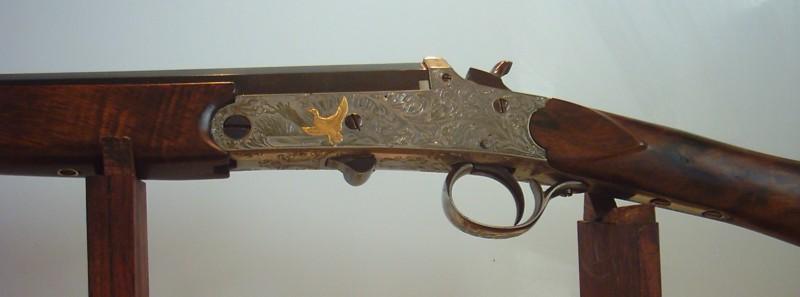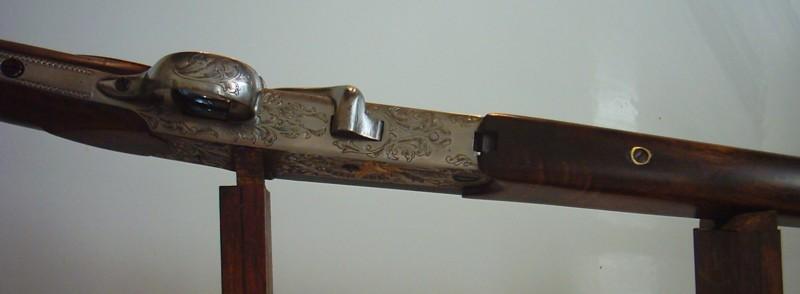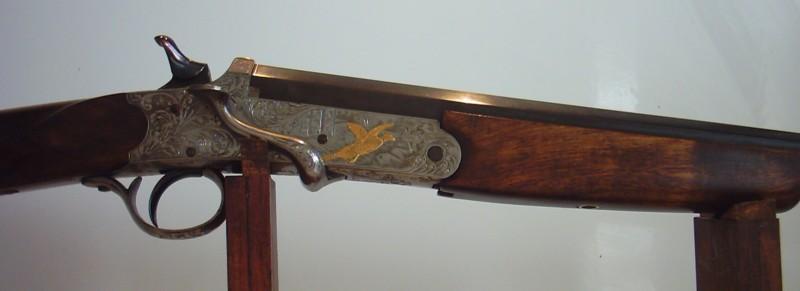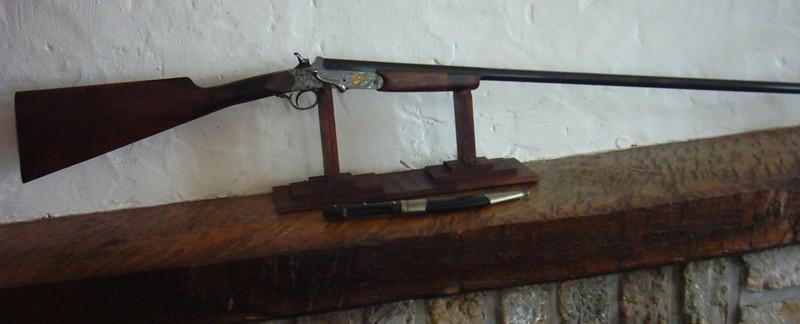Some of the most beautiful work of this craftsman, and many others, are in this book “Liège Gunmakers through their Work. 1800 - 1950”.
For more detail see: LIEGE GUNMAKERS
PIOT-LEPAGE & LEPINE under all reserves
It is about a carbine (or rifle) of type LECLERC to key of opening known as “snake”.
It nicely is engraved and damascened.
I did not see on the photographs any mark or punch?
I do not have a certainty as for the mark LLP, it could be a question of PIOT-LEPAGE & LEPINE (Proof house of Liège 1886/1890).
GG
A VERY NICE LIEGE-MADE SHOTGUN...
I have great pleasure in presenting the most beautiful of all my long arms, and of which I am very proud. It is an example of what can still be done at Liège today. That shotgun has an own history...
It is a single-barelled hunting shotgun of the Dumoulin type, with a sidelever. With its 28 gauge, it is made for the hunt on small game from hidden position. I found it in a corner of the workshop of a friend of mine, who is a professional gunmaker-engraver-inlayer at Liège. It was dirty, roughly finished, and covered with a tiny lay of rust. There were no engravings, and on the barrel there was only the EL stamp indicating provisional proof. Very remarkable were the stock and forewood of first quality walnut.
It was for sale, and it was cheap, so I bought it.
Made around 1900, the shotgun was actually intended for a luxury finish; but it was never finished but roughly just in order to pass the provisional proof. After that it never found a buyer and remained unfinished, stored from one gunmaker's cellar to another one's attic, until that day in 2003 I found it.
My friend sold it to me, but did not allow me to take it away immediately. "Let me make it presentable" , he said.
The result can be seen on the pictures. My friend finished the work that was left unfinished by hes predecessor a century ago. The gun has been completely finished, tuned, engraved and gold inlaid by hand. The engraved hunting scenes are of a very amazing depth and are embellished by a golden duck and hen in the frontplan, inlaid in fine gold wire. The side ornementation of floral style is engraved "with pearl bottom" and is in perfect accordance with the bucolic landscapes.
The same ornementation is repeated in lighter style at the underside of the receiver, the trigger guard and the backstrap.
The sidelever head and the upper backstrap are finely hammered. The hammer, trigger and screws are flame-blued.
The first grade walnut stock and forewood, left unchequered in order not to disturb the natural wood design, have been finely oil polished with linseed oil.
The barrel was blued by hot layers and is embellished with a fine golden fillet at the chamber.
This fine job took 160 hours of handwork.
What I have here is a mint condition, unfired shotgun, aged more than 100 years...
Notes
Thousands of Dumoulin type shotguns were made and even exported, mostly to England. They were copied in France, where even pinfire versions were produced.
They feature various calibres, ranging from the .22 rifled bore to the 20 gauge smooth bore, through the 410, 28, 32, 34...
They can be either single or double-barrelled, side-by-side. The double-barrelled ones often feature two calibres, for instance a .22 with a 410 gauge, etc. Some have two hammers and two triggers, others are fitted with a singla trigger and a single hammer that can be inclinated to the left or the right at the shooter's convenience.
Some feature a push-button on the frame behind the hinge; pressing the button allows for the barrel to be folded completely alongside the stock, making the gun more concealable. Those are called "smuggler's rifles" and are prohibited in Belgium.
Those guns feature a rebounding hamme, and a floating firing pin mounted in the receiver. A smart system allows for the hammer to rebound immediately after having hit the firing pin, and before the shooter has released the trigger.
When the hammer falls down to hit the pin, it squeezes a weak spring ahead of it. Once the percussion has been done and the energy of the main spring has been absorbed, the weaker spring pushes the hammer back, allowing for the firing pin to draw back as well in its channel, freeing the way for the extractor when the gun is opened to eject the empty shell.
These very elegant shotguns are loved by collectors. They became quite scarce now, and the engraved ones, in good condition, reach high prices.
Marcel



